He certainly had the credentials of a Texas cattle baron: As a boy he drove herds up the Chisholm Trail. As a man he owned a ranch that spread over three counties, built a mansion on Quality Hill and, after the last roundup, bunked down in a mausoleum in Oakwood Cemetery.
He also had one of the most storied surnames in the history of Texas ranching.
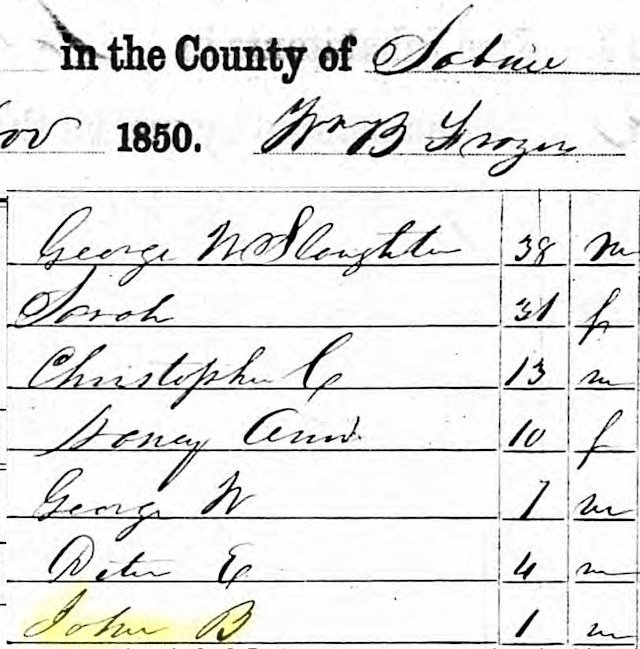 John Bunyan Slaughter was born in 1848 in Sabine County to George Webb and Sarah Jane Mason.
John Bunyan Slaughter was born in 1848 in Sabine County to George Webb and Sarah Jane Mason.
George Webb Slaughter had come to Texas in 1830 from Mississippi, served on the staff of Sam Houston during the Texas Revolution, delivering a message from Houston to William B. Travis at the Battle of the Alamo in 1836. When Slaughter and Sarah Jane Mason married in 1837 they became the first Anglo couple to marry in the Republic of Texas.
In 1857 George Webb Slaughter moved his family to Palo Pinto County. Slaughter, a Baptist preacher, had a church in Slaughter Valley. He also practiced medicine. And raised cattle.
George Webb and Sarah Jane had six sons, all ranchers who built empires in west Texas, New Mexico, Arizona, and Utah. John Bunyan and older brother Christopher Columbus are the best known of the Slaughter sons. C. C. Slaughter, called the “cattle king of Texas,” by 1905 ranched forty thousand head of cattle on more than one million acres of land.
Texas historian J. Frank Dobie said, “No cowman name, especially among cow people, has ever been known more than that of Slaughter.”
John Bunyan grew up on the back of a cow pony, working for his father and brother C. C. During the Civil War John registered his “U Lazy S” brand. In 1866 the father and two sons drove cattle up the Chisholm Trail to Abilene, Kansas. After Native Americans ambushed the drovers and killed the trail boss near the Red River crossing in Montague County John took charge of the herd at the urging of the other cowboys. He was eighteen years old.
John was paid $15 ($265 today) a month as a drover. George Slaughter, impressed by John’s thrifty use of his wages, rewarded his son with a gift of thirty calves. Those calves were the beginning of John Bunyan Slaughter’s cattle empire.
Encounters with unwelcoming Native Americans were an occupational hazard for Anglo ranchers. The Star-Telegram later wrote of John Slaughter: “In the spring of 1871, when he was twenty-three years old, Slaughter was shot by an Indian, the bullet going completely through his body. Six weeks later, however, he was back in the saddle. He was shot by Indians on four other occasions.”
In 1877 John formed a partnership with his brother William Baxter Slaughter, born in 1852. They raised cattle in Crosby County and drove them to market in Kansas.
In 1880 John established a ranch in Blanco Canyon on the Catfish River in Crosby County. That year he also married Isabella Masten May.
In the 1880s he went west, establishing ranches in New Mexico and Utah.
In 1890 he moved his operations to Glasscock County east of Midland.
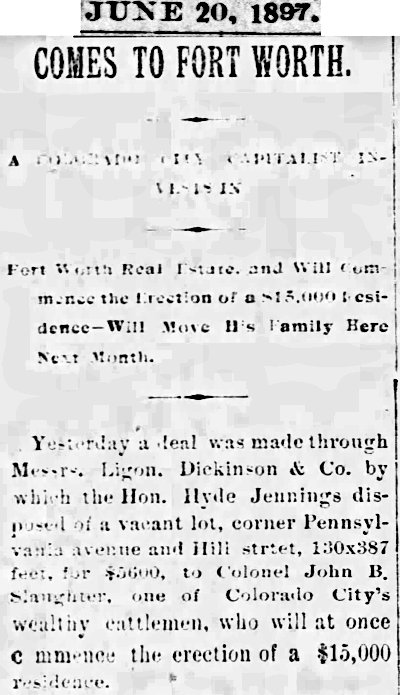 In 1897 Slaughter and his family moved to Fort Worth, where he built a mansion on Quality Hill for $15,000 ($470,000 today). The faded top headline reads “A Colorado City Capitalist Invests in.”
In 1897 Slaughter and his family moved to Fort Worth, where he built a mansion on Quality Hill for $15,000 ($470,000 today). The faded top headline reads “A Colorado City Capitalist Invests in.”
Other Quality Hill cattlemen included W. T. Waggoner, Samuel Burk Burnett, Winfield Scott, Cass Edwards, brothers William David and George T. Reynolds, George B. Loving, Franklin Hayes McFarland, Fountain Goodlet Oxsheer, Byron Crandall Rhome, James H. Nail, and C. A. O’Keefe, who was Slaughter’s next-door neighbor.
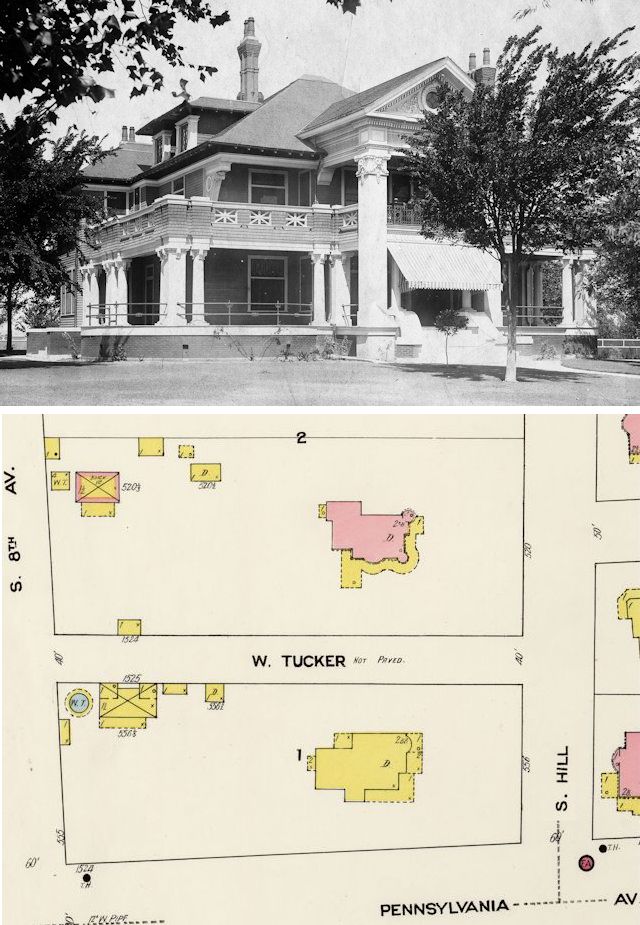 Slaughter’s mansion at 556 South Hill (later South Summit Avenue) was on property that covered the entire block where the Westchester House was built on Pennsylvania Avenue in 1951. At the rear of the property were a water tank and carriage house. C. A. O’Keefe’s house can be seen to the north at 520 South Hill. (Photo from University of Texas at Arlington Libraries.)
Slaughter’s mansion at 556 South Hill (later South Summit Avenue) was on property that covered the entire block where the Westchester House was built on Pennsylvania Avenue in 1951. At the rear of the property were a water tank and carriage house. C. A. O’Keefe’s house can be seen to the north at 520 South Hill. (Photo from University of Texas at Arlington Libraries.)
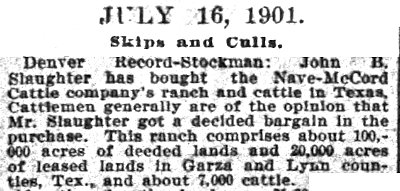 In 1901 Slaughter bought the 100,000-acre Square and Compass Ranch of the Nave-McCord Cattle Company in Garza and Lynn counties. He continued to acquire land until he had 156,000 acres in Garza, Lynn, and Borden counties and established his U Lazy S Ranch with its headquarters in Garza County.
In 1901 Slaughter bought the 100,000-acre Square and Compass Ranch of the Nave-McCord Cattle Company in Garza and Lynn counties. He continued to acquire land until he had 156,000 acres in Garza, Lynn, and Borden counties and established his U Lazy S Ranch with its headquarters in Garza County.
Slaughter built a mansion on the U Lazy S ranch, and for a while the Slaughters divided their time between Fort Worth and the ranch.
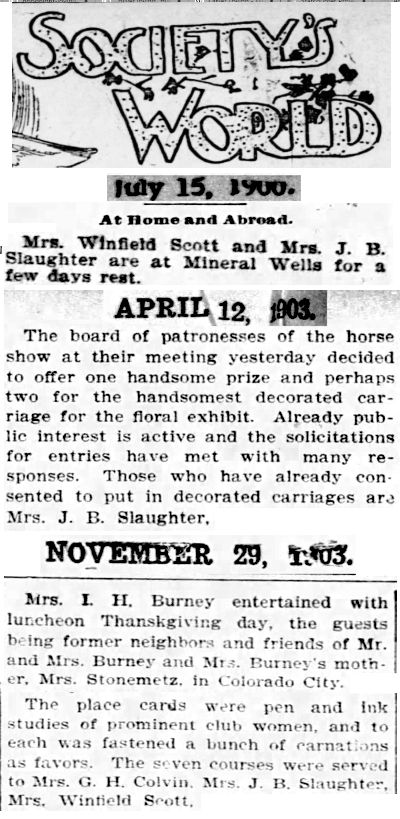 Mrs. Slaughter was active in Fort Worth society and was often mentioned in the society pages of local newspapers.
Mrs. Slaughter was active in Fort Worth society and was often mentioned in the society pages of local newspapers.
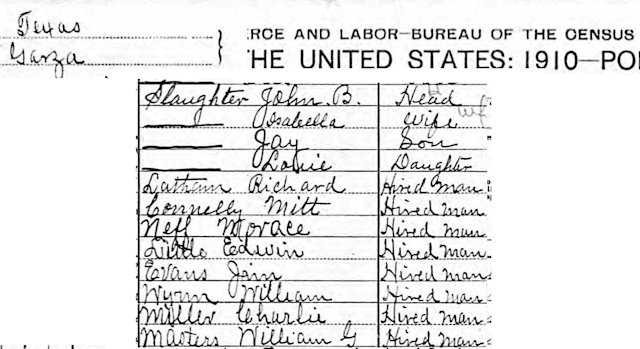 The Slaughters lived in Fort Worth about twelve years. By 1910 they listed their residence as the ranch in Garza County.
The Slaughters lived in Fort Worth about twelve years. By 1910 they listed their residence as the ranch in Garza County.
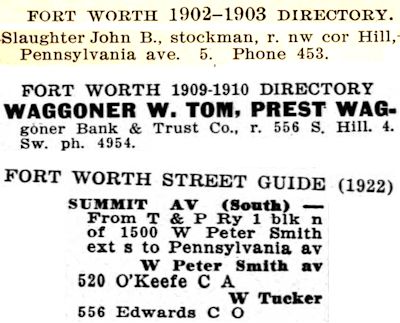 Call it the “Steakhouse”: As far as I know, the mansion at 556 Summit Avenue was unique in that three cattle barons lived there. John Bunyan Slaughter built it. The next cattle baron at 556 Summit was William Thomas Waggoner. After Waggoner moved to a still larger mansion farther north on Summit, the third and final cattle baron at 556 Summit was Cass Edwards. The mansion was demolished in 1949 to make way for the Westchester House.
Call it the “Steakhouse”: As far as I know, the mansion at 556 Summit Avenue was unique in that three cattle barons lived there. John Bunyan Slaughter built it. The next cattle baron at 556 Summit was William Thomas Waggoner. After Waggoner moved to a still larger mansion farther north on Summit, the third and final cattle baron at 556 Summit was Cass Edwards. The mansion was demolished in 1949 to make way for the Westchester House.
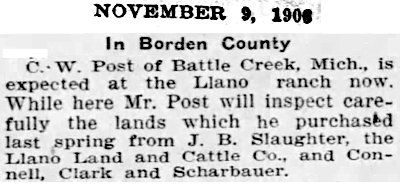 Meanwhile back at the ranch, in 1906 when cereal magnate Charles W. Post, who had moved from Fort Worth to Battle Creek, laid out the town of Post, Slaughter sold Post forty-eight thousand acres of the U Lazy S ranch. F. G. Oxsheer also sold Post twenty-four thousand acres in 1907. On the Slaughter land Post laid out his utopian town of Post, which prohibited alcoholic beverages and brothels.
Meanwhile back at the ranch, in 1906 when cereal magnate Charles W. Post, who had moved from Fort Worth to Battle Creek, laid out the town of Post, Slaughter sold Post forty-eight thousand acres of the U Lazy S ranch. F. G. Oxsheer also sold Post twenty-four thousand acres in 1907. On the Slaughter land Post laid out his utopian town of Post, which prohibited alcoholic beverages and brothels.
After the railroad reached Post in 1910, the town became the shipping point for Slaughter’s ranch.
John Slaughter gained recognition for crossing Brahma cattle with buffalos to produce the “cattalo.” He then bred cattalo back to one of the parent stocks to produce the “Vernier,” which was said to retain much of the hardiness of its wild ancestors, to withstand more drought and cold, and to survive on shorter grass.
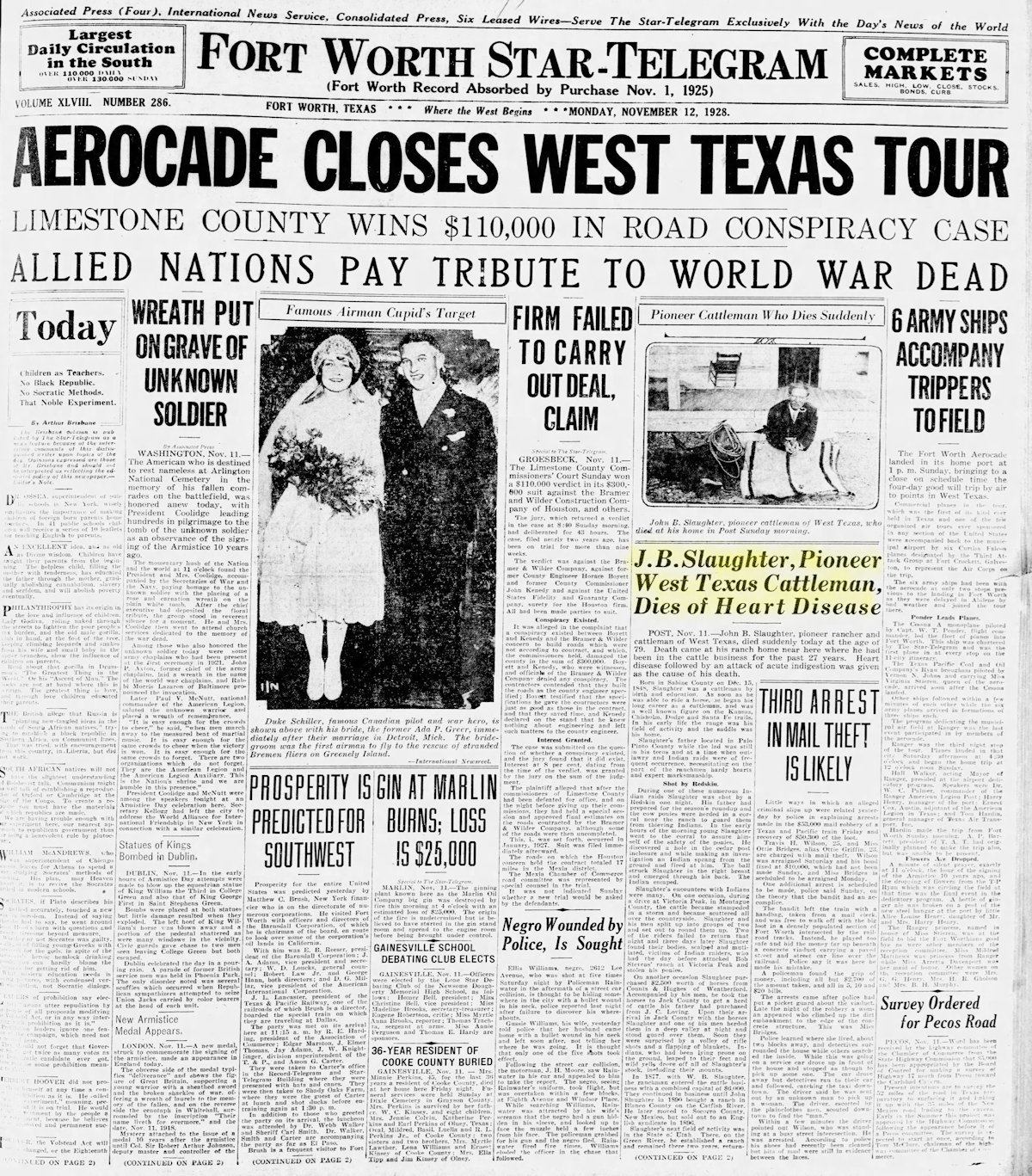 John Slaughter died in 1928 at age seventy-nine. Until shortly before his death he had been saddling up six days a week to check on his cattle, windmills, fences, and stock tanks on his U Lazy S ranch, which still covered ninety thousand acres.
John Slaughter died in 1928 at age seventy-nine. Until shortly before his death he had been saddling up six days a week to check on his cattle, windmills, fences, and stock tanks on his U Lazy S ranch, which still covered ninety thousand acres.
 Slaughter is buried in Oakwood Cemetery along with cowmen Winfield Scott, Burk Burnett, W. T. Waggoner, F. G. Oxsheer, B. C. Rhome, W. D. Reynolds, and George B. Loving.
Slaughter is buried in Oakwood Cemetery along with cowmen Winfield Scott, Burk Burnett, W. T. Waggoner, F. G. Oxsheer, B. C. Rhome, W. D. Reynolds, and George B. Loving.






He was my grand-grand uncle ,my mother mother was married willaim Evertt slaughter.had 7 kids.
Thank you for visiting the site. Unfortunately the author, Mike Nichols, passed away and we are working on how best to preserve this informative site.
I’m guessing that my classmate at Trinity Valley School for Boys from 1961 to 1965, J. Mack Slaughter, was this man’s grandson, or perhaps great grandson.
“Slaughter” is a fairly unusual surname, and there was more than one Slaughter in the cattle business in Texas, so I would not be surprised.